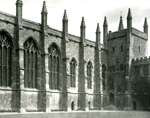Great British Architects: William Wynford
A master of small-scale design, Wynford was the poster boy of medieval gothic architecture


* For more architecture articles like this, subscribe and save
William Wynford was among the most brilliant exponents of the late-medieval Gothic style known as the Perpendicular. Working in a succession of major secular and ecclesiastical commissions, his buildings are regularised in plan, with their elements carefully massed for effect. They also make use of applied decoration as a means of underlining the function and relative significance of different spaces or structures.
Particularly important in his career was his connection with William of Wykeham, Bishop of Winchester from 1366. Through Wykeham’s patronage, Wynford’s practice became focused in the south-west of England. The example of Wynford’s work was to influence the English architectural tradition into the 17th century. The royal works Of Wynford’s early career and background, nothing is known for certain, although his name may suggest a connection with the village of Winford in Somerset. He is first documented in 1360 as a senior mason or warden supervising work on the remodelling of Windsor Castle for Edward III. This undertaking, one of the grandest and most influential palaces of the late Middle Ages, was to shape Wynford’s future career.
In artistic terms, the buildings at Windsor were among the first in a new style of Gothic architecture: the Perpendicular. This was an inventive fusion of English and French ideas that had been developed by a small circle of masons in the king’s employment. Buildings in this style were typically regular in plan, box-like in volume and with consistently detailed features such as windows and doors. Masons working in the Perpendicular idiom also made use of webs of panelling across wall and vault surfaces to integrate their designs visually.
Wynford was not only exposed to a new architectural style at Windsor, but he was also introduced to an exceptionally import-ant future patron. The king delegated responsibility for managing the castle works to a certain William Wykeham, a brilliant administrator and a trusted servant. Although Wynford never left royal employment working subsequently, for example, at the castles of Corfe, Winchester and Southampton for the king it was his connection with the powerful Wykeham that was gradually to direct his career.
A remarkable partnership
In 1365, Wynford was appointed master mason of Wells Cathedral, almost certainly through Wykeham’s interest. This was a post he held until his death and involved him in many operations in the close. Particularly important was the construction of the south-west tower of the church, which appears to have formulated the distinctive late-medieval tradition of Somerset parish churches.
Exquisite houses, the beauty of Nature, and how to get the most from your life, straight to your inbox.
Following Wykeham’s appointment to the extremely rich see of Winchester in 1366, Wynford’s architectural practice mushroomed. By 1377, Wynford was master mason of all the Bishop’s building operations. This involved him in the reconstruction and repair of numerous episcopal castles, palaces and manor houses, including those at Bishop Waltham, Farnham, and East Meon.
From 1394, he was involved in the remodelling of the vast 11th-century nave of Winchester Cathedral. Instead of demolishing the existing structure, he stripped it out, broadened the windows, refaced the interior and vaulted the whole to create a stylish interior in the Perpendicular idiom. At its centre, he designed a burial chapel for Wykeham.
More celebrated today than any of these projects, perhaps, was Wynford’s role in the design of two connected colleges that were founded by Wykeham and dedicated to the Virgin: the present-day public school at Winchester College and New College, Oxford. In each case, Wynford modelled the new buildings on the design of Edward III’s palace at Windsor. Showing the esteem in which he was held as a craftsman, he was portrayed in the glass of the college chapel at Winchester.
At his death in 1405, Wynford was the foremost mason in south-west England. The surviving documentary evidence securely identifies only a portion of his work. It is probable that the great tower of Wardour Castle, an masterpiece of Perpendicular design, was also designed by him. His career is a reminder that medieval masons could enjoy careers as successful, varied and geographically widespread as any architect in later centuries.
* For more architecture articles like this, subscribe and save
Country Life is unlike any other magazine: the only glossy weekly on the newsstand and the only magazine that has been guest-edited by His Majesty The King not once, but twice. It is a celebration of modern rural life and all its diverse joys and pleasures — that was first published in Queen Victoria's Diamond Jubilee year. Our eclectic mixture of witty and informative content — from the most up-to-date property news and commentary and a coveted glimpse inside some of the UK's best houses and gardens, to gardening, the arts and interior design, written by experts in their field — still cannot be found in print or online, anywhere else.
